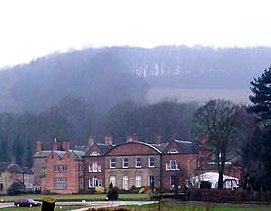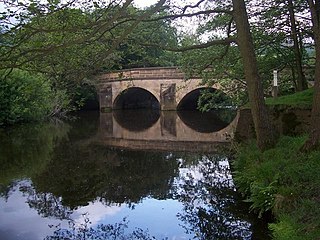
Tissington is a village in the Derbyshire Dales district of Derbyshire, England. The appropriate civil parish is called Tissington and Lea Hall. The population of this parish at the 2011 census was 159. It is part of the estate of Tissington Hall, owned by the FitzHerbert family since 1465. It is a popular tourist attraction, particularly during its well dressing week. It also gives its name to the Tissington Trail, a 13-mile (21 km) walk and cycle path which passes nearby. The Limestone Way, another long-distance path and bridleway, passes through the village itself.
Richard Topcliffe was a priest hunter and practitioner of torture during the reign of Elizabeth I of England. A landowner and Member of Parliament, he became notorious as the government's chief enforcer of the penal laws against the practice of Catholicism.

Grindleford is a village and civil parish in the county of Derbyshire, in the East Midlands of England. The population of the civil parish as taken at the 2011 Census was 909. It lies at an altitude of 492 feet (150 m) in the valley of the River Derwent in the Peak District National Park. The 17th-century Grindleford Bridge crosses the river on the western side of the village. On the west side of the valley is the 1,407 feet (429 m) high Sir William Hill, and to the south-east lies the gritstone escarpment of Froggatt Edge. Grindleford became a parish in 1987, merging the parishes of Eyam Woodlands, Stoke, Nether Padley and Upper Padley.

Haddon Hall is an English country house on the River Wye near Bakewell, Derbyshire, a former seat of the Dukes of Rutland. It is the home of Lord Edward Manners and his family. In form a medieval manor house, it has been described as "the most complete and most interesting house of [its] period". The origins of the hall are from the 11th century, with additions at various stages between the 13th and the 17th centuries, latterly in the Tudor style.

Great Chalfield Manor is an English country house at Great Chalfield, about 2.5 miles (4 km) northeast of the town of Bradford on Avon in the west of the county of Wiltshire.

Appleby Magna is a village and civil parish in Leicestershire and Derbyshire, England. It includes the small hamlets of Appleby Parva and Little Wigston, and the villages of Norton-Juxta-Twycross, Snarestone and Swepstone.

Padley Gorge is a deep but narrow valley in the Peak District, Derbyshire between the village of Grindleford and the A6187 road.

Markenfield Hall is an early 14th-century moated manor house about 3 miles (5 km) south of Ripon, North Yorkshire, England. It is in the civil parish of Markenfield Hall, which in 2015 had an estimated population of 10. The estate was an extra parochial area in the Hundred of Burghshire. It was made a civil parish in 1858. On 11 November 2011 the parish was renamed to Markenfield Hall. It was part of the West Riding of Yorkshire until 1974, when under the Local Government Act 1972 it became part of the new county of North Yorkshire. It is part of the Borough of Harrogate.

Burbage Brook is an upper tributary stream of the River Derwent in the Peak District of England.
Robert Ludlam was an English priest, martyred in the reign of Queen Elizabeth I. He was born around 1551, in Derbyshire. His father was a yeoman. He matriculated at St John's College, Oxford, in 1575, and remained there for two or three years, but left without taking a degree. He was admitted to the English College at Rheims on 25 November 1580, and the following September, he was ordained as a priest. He set out for England on 30 April 1582.

Swynnerton Hall is an 18th-century country mansion house, the home of Lord Stafford, situated at Swynnerton near Stone, Staffordshire. It is a Grade I listed building.

Norbury Manor is a 15th-century Elizabethan manor house and the adjoining 13th-century stone-built medieval Norbury Hall, known as The Old Manor in Norbury near Ashbourne, Derbyshire. It is a Grade I listed building.
Nicholas Fitzherbert was an English recusant gentleman who served as secretary to Cardinal William Allen and was found guilty of treason due to his Catholicism. He was the second son of John Fitzherbert of Padley, Derbyshire. Fitzherbert was the grandson of the judge Sir Anthony Fitzherbert (1470–1538), and first cousin to the Jesuit Thomas Fitzherbert. Whilst he was abroad, two priests were arrested at his father's house; they are now saints after becoming martyrs to their faith. Fitzherbert's lands were forfeit, and he was obliged to spend his life abroad. He was buried in Florence.

Norbury is a village in Derbyshire, England. It is located 3 miles (4.8 km) north of Rocester, on the B5033 road and the River Dove. The hamlet has links with George Eliot's family, the Evans. George Eliot's father, Robert Evans, was born in Roston Common and sang in the choir at Norbury church, and most of George Eliot's paternal ancestors are buried there.

Hopton Hall is an 18th-century country house at Hopton, near Wirksworth, Derbyshire. It is a Grade II listed building.

Hassop Hall is a 17th-century country house near Bakewell, Derbyshire, which was operated as a hotel until it closed on 29 September 2019. It is a Grade II* listed building.

Somersal Herbert Hall is a privately owned timber-framed 16th-century country house at Somersal Herbert, near Ashbourne, Derbyshire, in England. It is a Grade I listed building.

Padley Chapel is a building in Grindleford, England, on the site of the former Padley Hall. It is a Grade I listed building.
Sir Thomas Fitzherbert was an English member of Parliament and sheriff in England in the 16th century.

Highlow is a civil parish within the Derbyshire Dales district, in the county of Derbyshire, England. Largely rural, Highlow's population is reported with the population of neighbouring parishes for a total of 585 residents in 2011. It is 140 miles (230 km) north west of London, 28 miles (45 km) north west of the county city of Derby, and 7+1⁄2 miles (12.1 km) north of the nearest market town of Bakewell. Highlow is wholly within the Peak District national park, and shares a border with the parishes of Abney and Abney Grange, Eyam, Foolow, Grindleford, Hathersage as well as Offerton. There are nine listed buildings in Highlow.
















